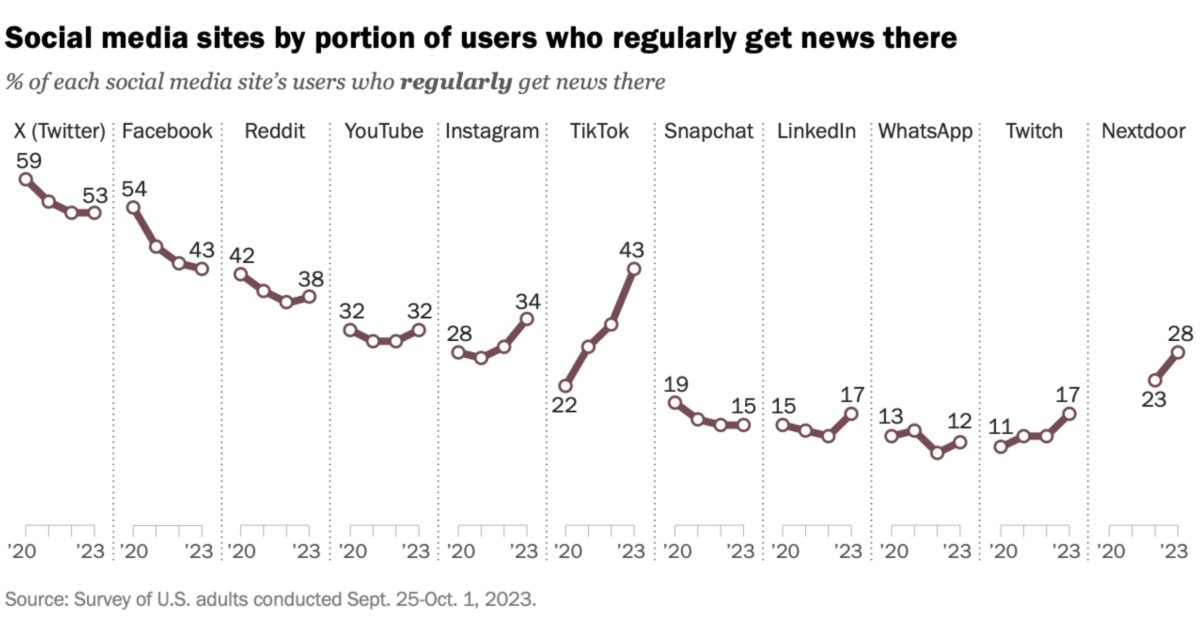In an era dominated by technology, social media has emerged as a source of information for many, causing the landscape of news consumption to undergo a transformative shift. With the increase in social media use globally, acquiring news from social media is inevitable – although it may have benefits, it has major liabilities.
According to Pew Research Center, 72% of the American population uses a form of social media. Popular social media platforms, such as Instagram, Facebook, and X (formerly Twitter), can be downloaded and used at no cost – this significantly contributes to their widespread accessibility and provides many with free news. On the other hand, commonly read newspapers in the United States, such as the New York Times, the Wall Street Journal, and the Washington Post, are not free, hindering their accessibility.
As stated by the New York Times, “Offer for a New York Times All Access subscription – current subscribers not eligible. Subscription excludes print edition. Some games may be available without a subscription. Your payment method will automatically be charged in advance the introductory offer rate of $4 every 4 weeks for 6 months and after 6 months the standard rate of $25 every 4 weeks.”
Social media is evidently a less costly platform, attracting a larger audience. An additional asset that social media offers is its relatability and capability to connect with individuals on a personal level – this is achieved through algorithms. Instagram, for example, curates social media posts in your feed that are related to what you have previously interacted with. This leads consumers to go down rabbit holes of a specific viewpoint on a topic; this approach can be problematic as it neglects diverse perspectives and is specifically risky as it may often foster or reinforce biases regarding news consumption.
An additional risk that comes with consuming information from social media or untrustworthy news sources is the possibility of misinformation, otherwise known as ‘fake news.’ Anybody on social media has the capability to post almost anything they want, with the exclusion of specific censorships. Consequently, the capability to put out information and claim it as news and reliable information is accessible to everyone. Contrary to this, traditional news outlets adhere to journalistic ethics, including fact-checking and an editorial process. When letters to the editors are submitted for publication in the Washington Post, for instance, they undergo a fact-checking process as well. Because publication on social media is not cohesive with an editorial process as such, misinformation can easily filter into these platforms and reach a broad audience before they are labeled as libelous or false.
In times of war, people are eager to see raw and unfiltered accounts. Amidst current events, such as the Israel-Hamas war, it is imperative for consumers to consider any and all possible bias or misinformation. While this is currently prominent, it is not new. In 2002, a terrorist suicide bombing by Hamas killed 30 and injured 140 Israelis at a Passover event. Israel soon after raided Hamas’ hub in Jenin, located in the West Bank.
“Palestinian sources originally claimed there were 3,000 dead in the street fighting, later lowering the tally to 500. An independent report found the actual number to be around 50, more than half of whom were terrorists. Despite the clarification, the myth of a Jenin massacre persists,” wrote Ivana Stradner and David May, researchers for the Foundation Defense of Democracies.
As exemplified in the Russian invasion of Ukraine, disinformation is common in warfare. In attempts to deny Ukraine’s right to exist and justify Russia’s invasion and other exterminating acts against Ukraine, Russia asserted fake news and propaganda. Not only does this aim to justify, but it propels hatred against Ukraine from Russian civilians and encourages Russian loyalty – these allegations were labeled as untrue.
Misinformation is everywhere, and it can be incredibly harmful. However, when it is tied into bias, such as through social media, it reaches a larger audience and can send consumers down a loophole in favor of a single perspective. This being said, social media still has truthful and reliable information in some circumstances. When consuming news from these platforms, it is vital to be aware of its negative attributes. Social media should not be a primary source of information for anyone. However, in instances where news is gathered from social media, it is imperative to fact-check information with reliable news sources to confirm its accuracy.


























